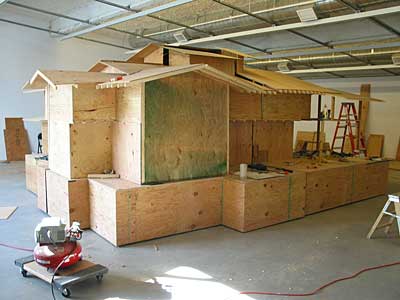Brian Jungen
dal 15/1/2004 al 14/2/2004
Segnalato da
California College of the Arts
15/1/2004
Brian Jungen
CCA Wattis Institute for Contemporary Arts, San Francisco
Capp Street Project. Inspired by an unlikely pair of artistic and architectural monuments from the twentieth century: Charles and Henry Greene's 1908 Arts and Crafts–style Gamble house and Gordon Matta-Clark's 1974 Splitting, a New Jersey suburban home that the artist cut in two, from top to bottom

Brian Jungen's Capp Street Project is inspired by an unlikely pair of artistic and architectural monuments from the twentieth century: Charles and Henry Greene's 1908 Arts and Crafts–style Gamble house and Gordon Matta-Clark's 1974 Splitting, a New Jersey suburban home that the artist cut in two, from top to bottom.
The Gamble home provides the basic blueprint: Jungen's project is essentially a crude scale model of the house's exterior, constructed with inexpensive plywood sheeting. The model has been roughly quartered, with each section placed atop two-foot-high mobile plywood pedestals that are moved throughout the gallery during the exhibition.
The structure's interior is home to an idiosyncratic library on architecture and crafts, including books and periodicals borrowed from the library of California College of the Arts. Students and faculty at the college wishing to read these publications will use Jungen's installation as a study center, partially transforming the function of the Logan gallery.
While it engages with ideas associated with social sculpture, Jungen's industrialized version of an Arts and Crafts landmark remains difficult to pigeonhole. It is at once an art installation, a library annex, a type of hybrid furniture including seating and shelving, and an architectural model. The borrowed and conflated aesthetics that the artist puts into play, meanwhile, serve as rhetorical hinges, or turning points, in a conceptual maze of linked ideas and allusions.
The Wattis
Kent and Vicki Logan Galleries, California College of the Arts, 1111 Eighth Street (at 16th and Wisconsin), San Francisco, CA 94107



